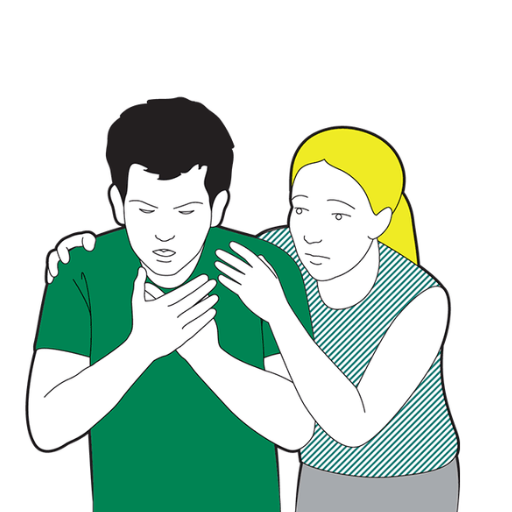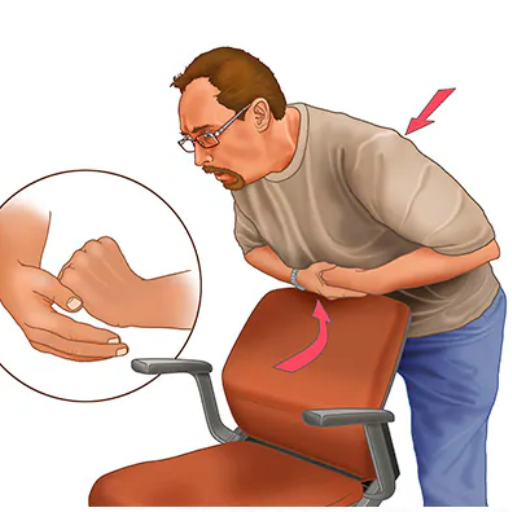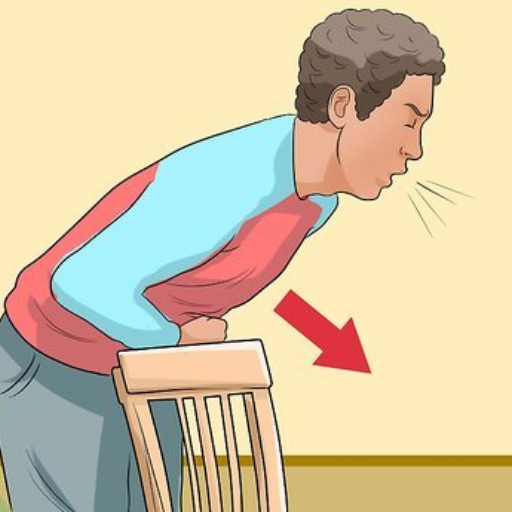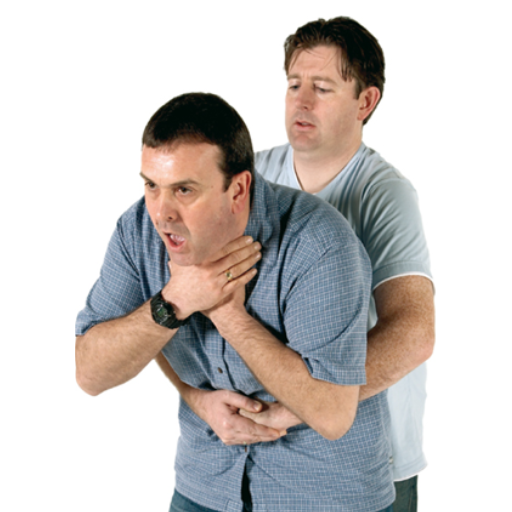
A person who is choking can become critically injured if not assisted right away. Focusing on the first steps to help someone choke is crucial regardless of the setting, be it the office, home, or outdoors. This is a how-to guide on providing first aid to a choking victim and describes proper procedures for assessing a person’s condition, giving necessary first aid, and following up to guarantee the victim receives appropriate care from a professional. Handling a life-fearing emergency by learning these steps can help save lives wherever and whenever a set of ribs situation occurs.
What Are the Choking Symptoms to Look Out For?

Right away, a person with a severe airway obstruction will exhibit some signs of choking, but the obstruction's severity usually dictates the symptoms observed. The most important ones are restlessness, inability to breathe or speak, wheezing while taking in air, and grasping their neck (the universal choking sign). Unlike partial obstruction, complete obstruction will undoubtedly result in a cyanotic condition, vigorous spasmodic coughing, and fainting. It is essential to note that these signs greatly help choose the proper treatment intervention.
How Can You Identify a Choking Person?
Recognizing the signs and symptoms of a choking person is understood by specific actions and physiological manifestations, which may include the following:
- Lack of Speech and Breathing: The person cannot breathe or talk, so the airway is completely obstructed, and normal respiration is impossible. Listen closely to determine if the sound of airflow is present.
- Gasping Sounds: An obstruction that may be caused by gas ping is abnormal relaxation of the larynx. This often occurs in those who are breathing heavily and experiencing wheezing stridor.
- Generally Accepted Signs Of Choking: The person in distress tries to clutch the neck region as a response.
- Cyanosis (Blue) Skin: A bluish discoloration around the lips and fingertips is due to lack of oxygen and poor flow.
- Coughing Distribution
- Severe Coughing: Poor airflow indicates an obstruction that is not entirely cut off.
- Gentle or Less Productive Cough: Signals a situation deteriorating further and leads to almost total obstruction.
- Behavioral Symptoms: Alongside choking, these symptoms can also show panic, restlessness, or agitation.
- Unresponsiveness: When an airway obstruction is not treated, the body slowly loses breath, resulting in instant hypoxia and fainting.
Detecting the signals above will allow for immediate life-saving measures such as abdominal thrusts and back slaps. Always determine the cause and severity of obstruction to develop the most suitable approach.
What to Do if the Person Becomes Unresponsive?
Once the individual becomes unresponsive, engage emergency medical services immediately or ask someone nearby to do it. If trained in CPR, commence with chest compressions. Position the victim on a flat surface and kneel beside them. Perform chest compressions at a rate of 100 to 120 compressions within one minute and a depth of at least 5 cm, making sure to let the chest totally recoil after each compression. If you are trained and can provide mouth between compressions, check for any obstruction and attempt to remove it gently if possible. If you are trained to administer rescue breaths, provide two breaths after thirty compressions. Continue providing CPR until professional help arrives, or move away once unresponsive signs start to appear.
How to Perform the Heimlich Maneuver Safely?

Check that the person shows signs of choking and cannot cough, speak, or breathe. From behind, wrap your arms around their waist and stand facing them. Form a fist with one hand and place it slightly above their navel, with your thumb facing them. Grab your fist and push inward and upward to dislodge the obstruction with your other hand. Continue until the object is no longer stuck or the person can breathe. For individuals who are obese or pregnant, push your fist against the lower sternum and perform inward thrusts instead. To prevent causing additional harm, continue being careful and try to look for medical help after performing the maneuver.
How to Stand Behind the Choking Person Correctly?
When helping someone choking, ensure your legs are slightly shoulder apart for balance. Now, position one leg slightly forward to stabilize yourself. In preparation, position one of your arms around their waist and the other so your hands are placed just above their navel.
What to Do if Someone Else is Choking?
When assisting a person who is choking, my initial step involves overcoming my panic, as such situations can frequently lead to anxiety. I do this by gauging the situation. First, I know asking them whether they can breathe, speak, or cough is vital. If I am met with silence, I can be at ease knowing that I have correctly identified the matter at hand, so I proceed and place a call for medical attention. While I wait, I apply abdominal thrusts or maneuvering in the Heimlich position. From my location, I proceed to walk behind the person who is choking; I then place myself beside their waist and make a fist with one of my hands. That fist will be placed above the person’s navel. The other hand will be wrapped around the previous fist. While doing this, I will give sharp upward thrusts in an attempt to extract the object lodged in the person’s throat. If the individual becomes unconscious, my attention will turn toward the individual. I would start by laying them down before proceeding with CPR, ensuring that their airways are cleared and the blockage is removed.
What Are the Emergency Steps to Take if Someone is Choking?

- Assess the Situation
Ask the person if they can speak, cough, or breathe to determine if they are choking. If they are unable to do so, proceed immediately with assistance.
- Call for Emergency Help
Dial 911 or your local emergency number to ensure professional medical assistance is coming.
- Perform the Heimlich Maneuver (Abdominal Thrusts)
-
-
- Stand behind the person and wrap your arms around their waist.
- Make a fist with one hand and position it just above the navel, below the ribcage.
- Grasp your fist with your other hand and deliver quick, upward thrusts. Continue until the object is dislodged or the person loses consciousness.
-
- If the Person Becomes Unconscious
-
-
- Carefully lay them on the ground.
- Begin CPR, focusing on chest compressions and ensuring the airway is clear.
- Check the mouth periodically to see if the obstruction becomes visible and can be removed.
-
- Monitor and Provide Support
Even after the obstruction is cleared, ensure the individual receives a medical evaluation to rule out any complications.
When should you call 911 or your local emergency number?
In the situations given below, you must immediately call your local emergency service number without delay.
1. Complete Airway Obstruction
If the person is neither responding nor can breathe, cough, or talk at all, it would suggest that emergency medical services need to be contacted as soon as possible.
2. Unconsciousness
Should the patient faint during any treatment procedure, inform medical personnel immediately. This will be considered an alarming development for which clinical assistance is urgently required.
3. Unable to Dislodge the Obstruction
Professional assistance is paramount if the airway has not been sufficiently cleared through pressure points or choking as a more radical method of alteration. Otherwise, the condition could worsen.
4. Signs of Severe Distress
Request assistance if the subject shows signs of severe distress like reduced air movement (wheezing), bluish changes in skin color around the mouth region or other parts suggesting an excessive reduction in oxygen levels, or other body parts showing decreased activity.
5. Potential for Secondary Complications
Even after successfully removing the hindrance, one should consider serious problems like inflammation around the lungs, internal bruising, breaking or chest discomfort, shortness of breath, or faintness as signs of further complications.
When you call your local emergency service number, try to include details such as the person’s age, the obstruction’s likely cause, current status, and other actions that have been made up to this point.
How to Help Save a Choking Person?
When attempting to save someone who is choking, I assess the person first to see if they are choking and cannot cough, breathe, or make any noise. If they can cough, I encourage them to do so, as this will help clear the airway. In the worst case, where someone may be genuinely choking, the Heimlich maneuver will have to be performed. I will do this by first standing behind the individual. I will then put my arms around the individual waist and form a fist just above their belly button. I will then perform heavy thrusts in an upward motion with my arms. If I realize the individual is unresponsive, I will check to see if the airway is obstructed and then perform CPR. While doing this, I will contact 911 or get someone to step outside and ensure that help is on the way for any possible consequences.
How to Clear the Airway Effectively?
To clear the airway, I will painstakingly evaluate the individual to determine if an obstruction exists while checking if they are alert or unresponsive. Suppose they are alert but unable to speak or cough. In that case, I will apply the Heimlich maneuver, which consists of abdominal thrusts, where I abruptly place pressure below the ribcage to assist in removing the obstruction. For children below one-year-old, I will administer five blows to the back before proceeding with five thrusts to the chest, ensuring they are forceful yet controlled. If the person is unresponsive, I will immediately commence CPR while checking for any obstructions in the mouth. In addition, I will try to remove any blockade I can reach without further pushing it more profoundly. During these procedures, I will try to be as composed as possible, ensuring that emergency medical support is on the way.
How Can You Help Someone Choking When Alone?

Taking swift action in an emergent situation like choking is undoubtedly imperative. If the person choking is alone, the first step should be vigorous coughing to expel the obstruction. If coughing fails, they can perform what is popularly known as the Heimlich maneuver or abdominal thrust. For self-abdominal thrusts, grab the fist with one hand and place it above the navel of the torso. Push it upwards and inwards quickly with forceful motions. Alternatively, the individual can apply pressure on a sturdy, firmly placed object like the back of a chair. Out of utter containment, the individual can also know that dialing the emergency services and remaining calm is vital if the blockage does not dislodge.
Techniques to Dislodge the Blockage Yourself
In the case that I ever find myself choking and alone, I would start by forcefully coughing to dislodge the object that may be blocking my airways. If that doesn’t seem to have any effect, I would start by giving myself abdominal thrusts. To do this, I would make a fist, place it above my navel, cinch my other hand around it, and then pull it upwards with as much force as possible. If that still does not work, I would place my body over a sturdy surface, like a chair or countertop, to give my abdomen a good amount of pressure. While leaning over the object, I would trust downward rapidly to try and free the object. While doing all these steps, remaining calm is key, and if my blockage is not resolved, contacting emergency services immediately is my best option.
When to Use Back Blows and Abdominal Thrusts on Yourself?
These techniques, which consist of abdominal thrust and back blows, must be used when you see clear signs of airway obstruction in an individual, such as inability to speak, breathe, or cough, while also showing signs of distress like holding on to the throat which is called the universal sign for choking. Actions must be taken immediately if the individual cannot cough or show signs of severe choking.
Back blows are the first recommended procedure to help dislodge the object when the obstruction is only occurring partially. To perform back blows on yourself, lean forward slightly and strike your upper back forcefully with the base of your palm in a repetitive, firm motion. The aim is to dislodge the obstruction item.
If there is complete airway blockage instead of partial, abdominal thrusts, also known as the Heimlich maneuver, should be used. Position your fist below the rib cage and treat it as a fist with the other hand. The next step is to perform aggressive thrust inward and upward to create enough internal pressure to remove the obstruction. If doing this using the edge of a chair, ensure that the correct area is struck with the pressure and thrust aggressively downward.
For both approaches, it is necessary to restrict the application of force so as not to self-inflict damage to the internal organs or ribs. More than one attempt might be needed, and progress should be assessed after every effort. Do not hesitate to call for emergency services if the obstruction still exists.
What Are the Choking Prevention Tips?

Take caution when eating food, such as chewing correctly and not talking or laughing. Young toddlers should avoid candies, nuts, or hard food items to minimize the risk of choking. Always supervise young children while they eat, as they can put little toys or other non-food items into their mouths. Elderly family members should be educated about proper mealtime etiquette. Those who struggle with swallowing should also seek medical attention for appropriate dietary measures.
How to Avoid Foreign Object Blockages?
A clear preemptive strategy and a careful attitude when dealing with small items or food is crucial in avoiding blockages from foreign objects. For young children, toys with detachable parts and items like coins, batteries, buttons, and toy parts should all be kept out of reach as they are common choking hazards. Items easily mistaken for food, such as small machine parts, should also be removed from the reach of adults working in settings like factories. Following the CPSC and ASTM international guidelines is vital.
While chewing your food, it is essential to avoid blockages and throat silos by chewing small portions. Grapes, hotdogs, and raw vegetables should be cut into bite-sized pieces for children under the age of three years. For children under three years old, the guidelines suggest 0.5-inch cut sizes. For adults suffering from dysphagia, specially modified diets and thickened liquids may be recommended under the assistance of a trained speech-language pathologist.
Besides this, all family members or coworkers should be trained on the dangers of ingesting or aspirating foreign objects. Implement emergency measures like the Heimlich maneuver and regularly check the environment for any feasible risk of choking. Integrative prevention includes attentive behavior, safe activities, and measures to deal with emergencies.
Why American Red Cross Training is Important?
American Red Cross training is paramount because it offers comprehensive, evidence-based knowledge and training essential for emergency preparedness. Courses equip learners with requisite skills for effective response to CPR, first aid, and other medical emergencies and disaster preparedness drills. Such empowerment saves lives and advances workplace safety requirements, making it a critical aspect of personal and career advancement.
References
- Mayo Clinic: First Aid for Choking
- American Red Cross: Adult & Child Choking First Aid
- MedlinePlus: Choking and Heimlich Maneuver
Frequently Asked Questions (FAQ)
Q: What should you do first when someone is choking?
A: When someone is choking, first ask if they can speak or cough. If they cannot, stand behind the person, lean them forward, and deliver five back blows between the shoulder blades using the heel of your hand. This is an essential first-aid step.Q: How do you perform abdominal thrusts on an adult?
A: Stand behind the person, wrap your arms around their waist, and place a fist just above their belly button. Grasp your fist with your other hand and perform quick, upward thrusts into the abdomen. This is often called the Heimlich maneuver and should be done five times if necessary.Q: What is the correct technique for helping a choking infant?
A: To help a choking infant, hold them face down on your forearm with their head lower than their body. Use the heel of your hand to deliver five back blows between the shoulder blades. Then, turn the infant over and give five chest thrusts using two fingers in the center of the chest.Q: What should you do if the person becomes unconscious?
A: If the person becomes unconscious, gently lower them to the ground and call for emergency medical help. Begin CPR with chest compressions and rescue breaths if you are trained to do so. Keep doing this until professional help arrives.Q: How can you help yourself if you are alone and choking?
A: If you are alone and choking, try to perform abdominal thrusts on yourself by placing a fist above your belly button and thrusting it inward and upward. You can also lean over a solid object, like a chair, to help dislodge the object.Q: When should you call for emergency help?
A: Call for emergency help immediately if the person cannot breathe, cough, or speak or if the situation does not improve after performing back blows and abdominal thrusts. Quick medical intervention is crucial as choking is life-threatening.Q: What is the risk of choking in different age groups?
A: Choking can happen to anyone, but children and the elderly are at higher risk due to smaller airways or difficulty in swallowing. Knowing the appropriate choking first aid techniques for adults and children is essential.Q: What resources are available to learn more about first aid?
A: Many resources are available for learning first aid, including free apps and courses offered by organizations like Mass General Brigham. These can provide valuable information on choking and other emergency medicine topics.Q: How important is it to act quickly in a choking situation?
A: It is crucial to act quickly when someone is choking because the lack of oxygen to the brain can lead to serious injury or death. Immediate action can save a life by helping to remove the stuck object from the windpipe.







 Login with Google
Login with Google Login with Facebook
Login with Facebook